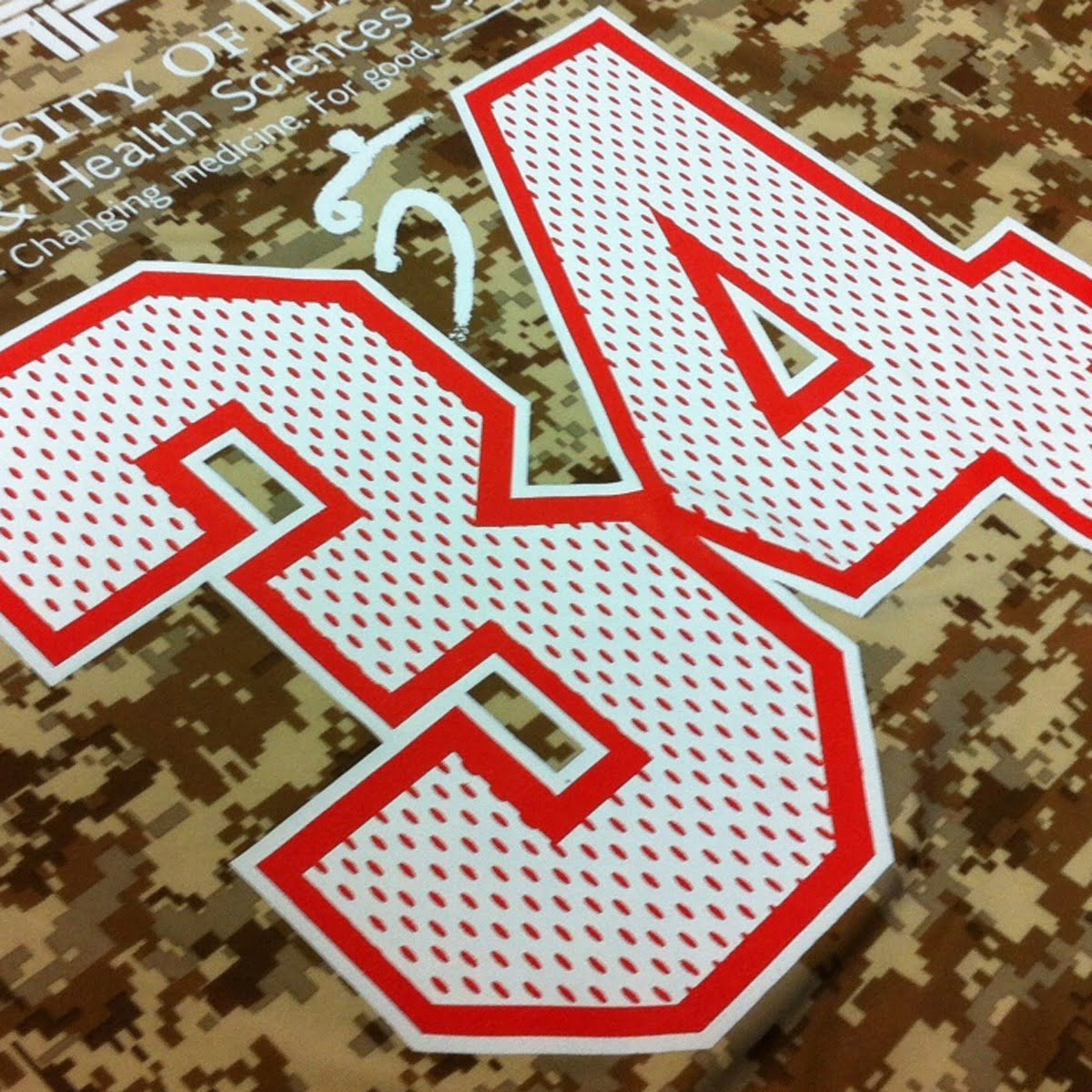What is one of the number one growth area in the decorated apparel industry? Performance and Athleisure wear. The good news is that your shop can benefit directly from this boom by decorating on these trendier tech apparel blanks. Maybe you already are, and that’s great. There is a better margin in them too; as they prove to be more difficult for some lesser educated or experienced shops to handle. I’ve talked to plenty of new customers over the years that left their previous decorator because the white ink turned pink on some red polyesters shirts (see the picture above – does this look like your handiwork?), and the printer didn’t take responsibility for the challenge.
In their clumsiness is an opportunity.
However, it’s really not that difficult to get your shop dialed in to print this stuff if you have the right mindset and attention to detail. Below are a few things to consider when printing on polyester performance apparel.
First, let’s take a look at the fabric of these shirts. Polyester performance fabrics are synthetic. They feel and print differently than cotton or even a 50/50 shirt. A good bit of the time they are just 100% polyester, but sometimes there is another percentage of a stretchable thread woven into the garment to give it some added elasticity. These garments are made for active people doing things and are being sold for their moisture-wicking properties. Garments are usually very lightweight, slinky, and if you have ever tried to fold a stack of these…hard to deal with sometimes. (Mine always look like my kid did the laundry.) But at the end of the day, they are just shirts. You just need to dive deep into the proper technique in how to print them.
What Sticks Out
So what’s the biggest issue with printing on polyester performance apparel? Dye migration by a mile. This is when the dye of the fabric leaches up through the lighter printed inks in the design, causing an unwanted color shift. It sucks. Mainly because this doesn’t happen in front of you, but quite often in the box, while it’s on it’s way to the customer. It’s a time bomb. You think your print looks great. They think it’s a disaster. Get ready for some yelling, followed by some major butt kissing.
It doesn’t have to be this way though. Here’s the secret to your success in three easy steps:
- Control the heat.
- Use the right ink.
- Be careful.
That’s it. Ok, article over…right? Not so fast. Let’s dive into these a bit and see what they mean.
Control the Heat
Where shops start traveling down the wrong road is not looking carefully at how they are using heat in the process. It’s the best thing you can do, and the one that’s mostly ignored. I think by now most everyone is adept at least using a low-bleed, high opacity ink for polyester. (Uh, right?) The big speedbump is not thinking it through and looking at the cumulative effect of the temperature and dwell times of the flash units, and the temperature and belt speed of the dryer. It all adds up. A lot of ink gets blamed for not working, but instead, it was a heat issue that should be called out instead.
In your shop do you emphasize this on polyester print production orders? Is there any discussion before the job starts? Does your shop have a special note or call to action to do anything different?
“WATCH THE HEAT!” or “POSSIBLE DYE MIGRATION ISSUES!”. Some gigantic alarm trigger on the work order? Be careful!
Probably not.
Most low bleed inks cure at 270-290 degrees. Regular plastisol inks cure at 320 degrees. Now, look at the temperature setting on your dryer right now. 350? 375? 400? Be honest.
While we know that the temperature gauge only measures the ambient temperature in the chamber and not the actual temperature of the ink as it’s going down the belt…the only way to know for sure is by testing with a donut probe. If your shop doesn’t have one of these gadgets, order one today. I’m not kidding.
The probe is shaped like, you guessed it, a donut. The crossed wires inside the probe are placed on the wet ink on the shirt going down the belt. Want to control the temperature exactly for your job? Measure this and adjust your dryer so you hit the right number you need. Remember, these inks cure at the exact moment they hit their cure temp. Added heat doesn’t cure them any better or give you any sort of boost. For polyester, you are just exponentially adding more danger to the job with every degree higher than the cure temperature of the ink on the shirt as designed by the ink manufacturer. Dial that dryer heat down and save yourself some frustration later.
So what’s the second biggest issue?
Hot polyester shirts falling off the belt and going into a box/hamper, getting placed in a big stack on the catcher table, or worst of all – going straight into a box for shipping.
Anyone of these three scenarios all produces the same result, which is just continually baking the shirts. If you have ever gotten a weird pattern in your printed ink and can’t figure out where that crazy Shroud-of-Turin-like image came from, this is what happened. Your Betty Crocker Cardboard Box Shirt Oven was still on. Ut oh.
The cure for this is to stack the shirts coming down the belt into three or four piles on the dryer table. As shirts come down, pull the next one from the belt and place it on the next stack in the row. Have a fan blowing air on these shirts. Keep working the rows and stacks and the hot shirts will go on top of the cooled ones. Never hot on hot. Your number one goal is to get them to be cool to the touch as quickly as possible. If you can feel any heat at all, do not place them in a box for shipping until they don’t have any residual heat leftover.
Also, make sure they are cooled completely down before printing another location. Polyester shirts should never drop off a dryer belt and into a hamper or box. Either get a better-trained catcher or give them some help. These shirts aren’t cheap to replace, and neither is a customer leaving you because your catcher can’t keep up. If you are a one man shop printing polyester shirts that day, bring in your neighbors’ kid or your wife or someone to help on that job.
Use the Right Ink
So let’s talk about ink. While I purposely don’t name manufacturing brands much, as I try to stay neutral on this blog, I feel it would be a disservice to not mention my favorite dye-migration Force Field, which is the Wilflex Epic Performance Underbase Gray and Epic Performance White system. Yes, I purposely used the words “Force Field”.
These two, when used together, hit home runs every single time and absolutely control any dye-migration challenges. They even block out sublimated camo, stripes or other patterns in sublimated patterned polyester apparel.

The gray is incredibly thick though. Use a drill or mixer and work the ink in the bucket before using to get the viscosity better. It prints easier when it’s been a little active. (Like me in the mornings after three cups of coffee.) The white is so good you won’t need a highlight white. The image above is just the UB Gray, Performance White, & Red. Also, if you have a roller squeegee, be sure to use that in the underbase cool down station after the first flash. You should be doing that anyway, but for polyester printing, it really gives the underbase layer a smooth and perfect foundation surface for other colors to drop down on. These inks are a little more expensive that other inks formulated for the same purpose…but if used correctly you will never have an issue.
How much is peace of mind worth anyway?
Lots of shops have fantastic results printing with waterbase and silicone ink too. Waterbase ink has an alien-sounding “Bleed Blocker Black” that is used instead of white. I’ve done some performance testing with red polyester shirts and with a black underbase and white top screen, and printed a great looking result. Soft hand, with fantastic stretch.
Silicone works great too but has a more rubbery feel and you have to absolutely flash after every color. A lot of the shirts that Nike or the other shoe companies put out are printed with Silicone ink. This ink is much more expensive than plastisol or waterbase but has some excellent print properties. It works with a catalyst, so it’s a two part system with a limited pot life. For the right production application, this is perfect.
While we are discussing ink, we should talk about design if we can. For the most part, these types of shirts are used for some sort of athletic, sports, yoga, or purpose for people moving and sweating. Or just getting up off the couch to go get another beer because the game is in a commercial. (I’ll have one too!) It absolutely doesn’t do anyone any favors to utilize this type of performance shirt and then print some gigantic design that covers 100% of the available area.
Get your creative team to consider the user and work the “purpose” of this type of garment into their design thinking. Maybe instead of a full front, a center chest might be ok. What about instead of a huge solid circle of white, the designer just used an outline of the circle, and selected that to be a darker color that won’t even need to be underbased? Want to control your dye migration? Start with limiting the chance by minimizing the lightest colors from your crayon box. Sure, I understand that sometimes you have to use white, yellow or whatever…but if you can rethink how these are being used you are protecting your shop from a possible problem later on. Your client doesn’t have to know that. They just want something “that looks cool”. I’m sure your creative team can handle it.
Be Careful
Bullet List of Tips & Tricks – hey, add your own in the comment section!
- There are plenty of low cure additives you can use. These make your existing inks usable so you don’t have to buy new. Follow the manufacturer’s specific instructions on the percentage to mix in. It will be by weight. Don’t guess. Use a scale.
- If you use a low cure underbase, the colors printed on top should be low cure too. Nothing is worse than having a great underbase and the rest of the printed ink sloughing off the shirt after a wash. Do it right. See above.
- Plastisol usually cures at 320. Low bleed inks usually cure at 270-290. Use a donut probe and make sure you are hitting your temperature numbers. You know why now, right?
- Use screens with good tension (above 30 newtons), with the proper mesh count for usage in the print. 140 – 160 for underbase should be ok. Not enough ink? Look at your EOM, or maybe drop your mesh count down to a 110. 230 – 305 for colors. 230 for a highlight white if you need it. Remember for colors printed over a flashed underbase, the thinner the deposit – the less flash dwell time needed. This prevents the shirt from getting too hot. Control that heat.
- Spackling the shirt with so much ink to “cover” the fabric and hope you build it up enough to prevent the migration, not only makes the print feel like you stapled a cardboard box to the shirt, but will take forever to flash or dry. Which means that your brain tells you to increase the dwell times to compensate for that. So you add more heat and increase the likeliness of the problem you are trying to prevent. That’s a dog chasing its tail. Stop. It. Please.
- Optimize your print with perfect pressure and squeegee angle. You want the print sitting on top of the shirt, not driven into it like a nail. If you can see your print on the press platen, you have too much pressure. A thinner deposit cures faster and requires less flash dwell time too. Yes, it’s a recurring theme.
- For longer runs, as your production day goes on be sure to reduce your dwell times on your flashes as your boards heat up.
- Bold strong ink colors won’t have much of a problem with dye migration. No, you don’t have to underbase the navy or black to print on a lime green polyester shirt. Yes, I’ve seen artists do that.
- Be careful with unrecognizable inventory. If you haven’t printed on that particular brand or color before, treat it like it’s going to be your worst nightmare. (Because it is) Print a sample at the end of a shift and let it sit overnight. Better still, schedule it for a Friday afternoon and let it sit all weekend. If it looks great on Monday, you’ll know you did it right! If not, retrace your steps and find out what happened. Next step? Give it a wash test too!
- Of course, this means that either you’ll have to start that job earlier or get more time from your customer. Your choice…but you can do it if you properly plan. “Proper Planning Permits Peak Performance”
- A lower cost alternative is to use athletic base polyester inks, such as Wilflex Epic Top Score. This ink is engineered for athletic apparel.
- In production watch your team’s transition between printing 100% cotton to polyester and back again. Also, what happens if you change the dryer temp and belt speed for that job, but you have another press stationed for that dryer? Be sure those jobs on the neighboring press are being cured properly too. These failures occur most when shops are extremely busy and nobody has time to think…or when shops are slow and nobody is thinking because they are bored. Ok then, you got me. These problems happen when nobody is thinking. There, I said it. Pay attention!
- If you have multiple presses in your shop, try designating one of them to be the “Poly-Crew”, and all of these types of jobs are routed there for production. It’s easier to schedule. You’ll have a trained crew that will be the masters of the technique. Work in other crew members for training occasionally so you can broaden your knowledge base.
- A lot of buckets of white ink look the same, especially from across the shop. Try wrapping blue painters tape around the Polyester White bucket handle, so at a glance from twenty feet away you can tell what white to grab. If your crew has ever used the wrong white for a poly job, you’ll understand the need to this easy visualization to mark the correct bucket. There is nothing worse than seeing pink in areas that should be white just because the wrong ink was loaded in the screen.
- Review the garment label for thread properties. Beware of stretch in the garment. Especially with how you load the shirt. Circle designs become egg-shaped quickly. You can’t blame that on the ink either, as much as some people would want to.
So are you a master at printing on this type of garment? If not, do some research by trial and error and perfect your process. If you are, shout it from the rooftops! There is a lot of demand for this type of work, and not everyone does it well.
If you have a Pinterest board, a gallery on your website or other social media platforms be sure to regularly post polyester or performance print jobs so new customers can see that you have the chops to handle their order.
After all, not everyone is going to do it right like you!





9 comments
Adam Scaife
Marshall,
As Always from you, this is a really great educational article! You are spot on!! Both Epic Performance and Top Score were built for these fabrics and they perform awesomely when you run them as they are intended.
Watch your flash temps and dwell times closely as these plastisol inks coupled with these garments flash much quicker as well. Don’t over flash or you could create an inter-coat adhesion issue.
If on an automatic, cool down stations following a flash are nice. There have been some beautiful simulated process prints done on these fabrics using these inks since they came out. Mastering the wet on wet and where and when to flash vs stepping on a color or colors along with having a good sep that was intended for the meshes and colors
On the back side of the dryer cooling fans (not blowing into the dryer) directed down away from the dryer but onto the images and the garments on the run out belt are helpful prior to stacking.
Keep them coming Marshall!!
Jochen
Mr Atkinson, Thank you for another excellent article. I really look forward to each new post. Love your work!
I used to turn down most 100% Polyester jobs until I discovered the Wilflex Epic Underbase Grey. It’s a miracle ink and we now print the worst polyester garments with confidence. Just out of curiosity when it comes to potentially problematic poly cotton fleece, let’s say the Gildan 50/50, do you think there is any benefit in running the garments through the dryer prior to printing?
atkinsontshirt
Jochen – lots of shops do that, but to me it just adds extra work without much benefit. Better use of your time is controlling the heat, not adding another heating step. Watch your temps.
samirsadikoglu
Hi Marshal,
Great article and thanks for sharing !
I have a customer asking for discharge ink on synthetic fabrics , have you heard of any ?
All the best
Samir
Adam Scaife
Samir,
If your customer is looking for a smoother hand feel on athletic garments, have Marshall teach you how to build and use a smoothing screen to help smooth the image out on the garment. While you won’t have “no” hand feel, you will have low or lower hand feel. Discharge inks only work with dischargeable dyes which are typically made for cellulosic fabrics. I’ve not heard of or ever used dischargeable dyes on synthetics.
atkinsontshirt
Discharge only works with cotton fibers, so that might be hard to find.
Kjeld van Heijningen
Please also note as we print 1 million 100% polyester shirts annual for a large sports brand the following.
Bleeding can also happen weeks after prints are done even when blocker is used and a migration test is applied.
We always suggest to try and find out what dye was used for colouring the garment. If it is cationic you are very very safe, if not there is a risk always even when using the larger ink brands!
The other risk is bleeding other way around! If you print as example red shirts and stack them behind the dryer first let them cool a little before stacking hot on top of each other otherwise the backpanel will bleed into the front vise versa.